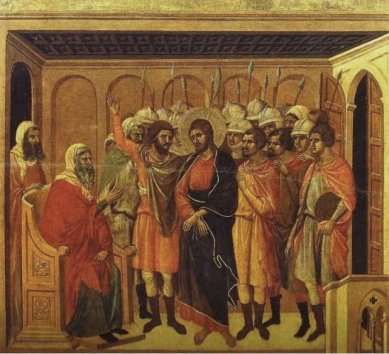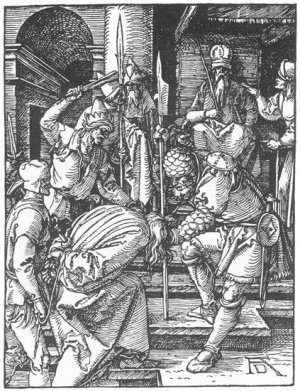|
Another episode – or
sequence of episodes – in which differences between the four gospels
causes confusion. There are
also wider issues, discussed in detail in my regular guide to such
things, The Passion by Geza
Vermes.
As with all the Passion
events, John’s gospel moves the arrest and trial a day early, so
Christ himself becomes the sacrificial paschal lamb.
This leads to discussions about whether the various meetings and
trials could have in fact taken place at this time under Jewish law.
The other major issue is to what extent the Gentile–focussed
gospels ‘spin’ the story to incriminate the Jewish Sanhedrin and let
Pilate off the hook. In particular, that part of the narrative where the
crowd is offered the choice of Christ or Barabbas is regarded as
suspect. No such tradition is mentioned by historians such as Josephus,
and he should know. even Matthew’s gospel, considered the
one aimed at a Jewish audience, includes the scene of Pilate washing his
hands, declaring himself ‘innocent
of the blood of this just person’. Matthew does his best to implicate
all of the Jewish people: 'Then answered all the people, and said,
His blood be on us, and on our children.' ("7 v 25).
The portrait offered of Pilate by the gospel writers as a
reasonable but irresolute official is also at completely at odds with
the reality described by authors such as the ever reliable Josephus (Jewish
War and Jewish Antiquities) and Philo (Embassy
to Gaius). Pilate was quite clearly a brutal and vindictive thug who
ended up being recalled to Rome to answer for his cruelty and
incompetence.
So a quick outline of the
main events, then a look at the differing details of each gospel.
Christ is arrested, and
brought before the high priest, who declares him guilty. He is beaten. Peter,
who has followed Christ, now denies knowledge of him.
The next morning Christ
appears before the council of elders and priests, the Sanhedrin, where
his guilt is confirmed. He is then taken to Pilate, who does not find
fault in him. However, pressure from the Sanhedrin changes his mind and
he offers the crowd the choice of Christ or Barabbas. Barabbas is
chosen.
Mark
In Mark, the priests,
elders, and scribes are already assembled at the house of the unnamed
high priest. Various
witnesses are brought forward, some ‘false’. Christ is
asked ‘Art thou the
Christ, the Son of the Blessed?’ His
incriminating reply is ‘I am: and ye shall see the Son of man sitting
on the right hand of power, and coming in the clouds of heaven.’
The high priest rents his
clothes and Christ is
‘buffeted’. The narrative continues as above.
Matthew
Matthew names the high priest as Caiaphas. This gospel includes
verses on the repentance and remorse of Judas.
Matthew includes two
details relating to Pilate. One is the washing of hands, mentioned
already. The other is the unsuccessful intervention on Christ’s behalf
by Pilate’s wife. She became, in legend, the Christian saint and
Martyr Saint Procula. (She has other names.)
Luke
In Luke, when Pilate
realises Christ is a Gallilean he sends him to King Herod. Herod hopes
to see miracles enacted, but Christ does not oblige – he is mocked and
returned to Pilate.
John
First, Christ is taken to the priest Annas, father-in-law of Caiaphas,
before being taken to the high priest himself. As
the cock crows, Christ is taken to Pilate , but the priests do not enter
the judgment chamber ‘, lest they should be defiled; but that they
might eat the Passover’.
The trial before Pilate,
with its discussion of the nature of kingship, is far lengthier in John.
The trials in art
By far the most comprehensive guides are the Maesta of Duccio and the
'Small Passion' woodcuts of Durer. Let's start with their
interpretations of Christ before Annas.
Duccio shows the moment when Christ is found guilty; Durer illustrates
the subsequent beating.
|

